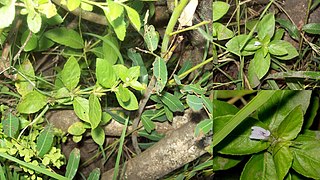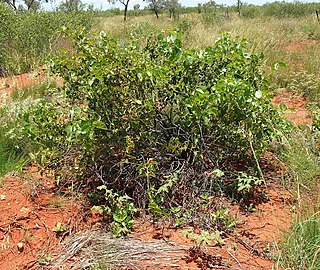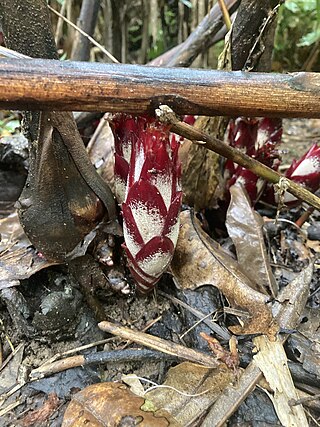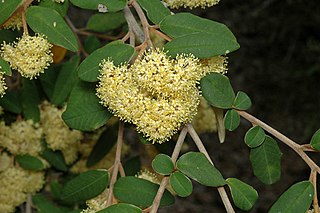
Zingiberaceae or the ginger family is a family of flowering plants made up of about 50 genera with a total of about 1600 known species of aromatic perennial herbs with creeping horizontal or tuberous rhizomes distributed throughout tropical Africa, Asia, and the Americas. Many of the family's species are important ornamental, spice, or medicinal plants. Ornamental genera include the shell gingers (Alpinia), Siam or summer tulip, Globba, ginger lily (Hedychium), Kaempferia, torch-ginger Etlingera elatior, Renealmia, and ginger (Zingiber). Spices include ginger (Zingiber), galangal or Thai ginger, melegueta pepper, myoga, korarima, turmeric (Curcuma), and cardamom.

Angophora is a genus of nine species of trees and shrubs in the myrtle family, Myrtaceae. Endemic to eastern Australia, they differ from other eucalypts in having juvenile and adult leaves arranged in opposite pairs, sepals reduced to projections on the edge of the floral cup, four or five overlapping, more or less round petals, and a papery or thin, woody, often strongly ribbed capsule. Species are found between the Atherton Tableland in Queensland and south through New South Wales to eastern Victoria, Australia.

Amomum is a genus of plants native to China, the Indian subcontinent, Southeast Asia, New Guinea, and Queensland. It includes several species of cardamom, especially black cardamom. Plants of this genus are remarkable for their pungency and aromatic properties.
Datin Anthea Phillipps B.Sc. is a British botanist based in Sabah, Malaysia, specialising in pitcher plants and rhododendrons.

Hygrophila costata, with the common names glush weed, gulf swampweed, and yerba de hicotea, is an aquatic plant.

Ipomoea costata, commonly known as rock morning glory, is an Australian native plant. It is found in northern Australia, from Western Australia, through the Northern Territory, to Queensland. Its tubers provide a form of bush tucker to some Aboriginal peoples, known as bush potato, or, karnti.

Angophora costata, commonly known as Sydney red gum, rusty gum or smooth-barked apple, is a species of tree that is endemic to eastern Australia. Reaching 30 m (100 ft) in height, the species has distinctive smooth bark that is pinkish or orange-brown when new and fades to grey with age. Its lance-shaped leaves are arranged in opposite pairs along the stems, with white or creamy white flowers appearing from October to December. The flower buds are usually arranged in groups of three, followed by ribbed, oval or bell-shaped fruit.

Planchonella costata is a small coastal tree native to the northern North Island and to Norfolk Island (Australia). In New Zealand, its common name is tawapou ; on Norfolk Island it is called bastard ironwood. The name costata is from the Latin costatus (ribbed), a reference to the prominently raised primary nerves of the leaves.

Anisoptera costata is an endangered species of plant in the family Dipterocarpaceae. The specific epithet costata means "ribbed", referring to the prominent venation of the leaf blade. A huge emergent tree up to 65 m high, it is found in evergreen and semi-evergreen lowland tropical seasonal forests of Indo-Burma and in mixed dipterocarp forests of Malesia.
Plerandra costata is a species of plant in the family Araliaceae. It is endemic to Fiji. It is known from two mountain tops, Mount Tomanivi on Viti Levu and the western slope of Taveuni island, where it grows in montane rain forest above 900 meters elevation.

Euodia is a plant genus in the family Rutaceae. Euodia is sometimes misspelled as Evodia. The species now included in the genus Tetradium were previously included in Euodia, and may be commonly referred to as euodia.
Dacryodes costata is a tree in the family Burseraceae. The specific epithet costata is from the Latin meaning "ribbed", likely referring to the prominent veins on the leaf underside.

Hellenia is a genus of plants in the Costaceae described as a genus with this name in 1791. It is native to Southeast Asia, southern China, the Indian Subcontinent, New Guinea, and Queensland. The type species was "H. grandiflora" Retz., which is a synonym of Hellenia speciosa.
Castanopsis costata is a tree in the family Fagaceae. The specific epithet costata is from the Latin meaning "ribbed", referring to the leaf venation.

Grevillea costata is a species of flowering plant in the family Proteaceae and is endemic to the west of Western Australia. It is a spreading shrub with sharply-pointed, linear leaves and white flowers.

Hornstedtia scottiana, common known as Scott's ginger, jiddo, or native cardamom, is a very large ginger native to Queensland, New Guinea and the Maluku Islands. Its fruits are eaten by the cassowary. It is also a food plant for the larval stages of the Banded Demon Butterfly.
Angophora costata subsp. costata is a species of medium-sized to large tree that is endemic to eastern Australia. It has smooth bark, lance-shaped adult leaves, flower buds in groups of three, white or creamy white flowers and cylindrical to barrel-shaped fruit. It is similar to subspecies costata but has narrower leaves and smaller fruit.

Betula costata is a species of tree belonging to the family Betulaceae.

Pomaderris costata is a species of flowering plant in the family Rhamnaceae and is endemic to south-eastern continental Australia. It is a spreading shrub with densely hairy branchlets, egg-shaped to elliptic leaves, and panicles of cream-coloured or white flowers.













